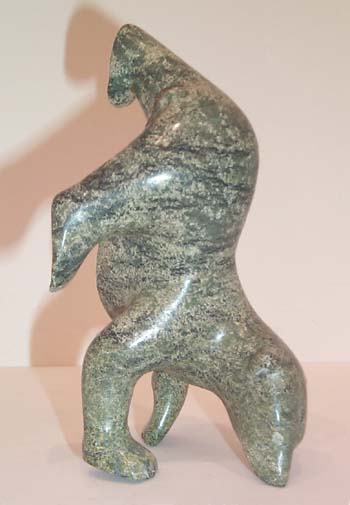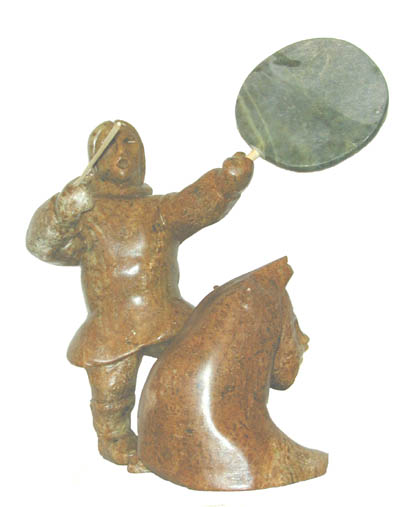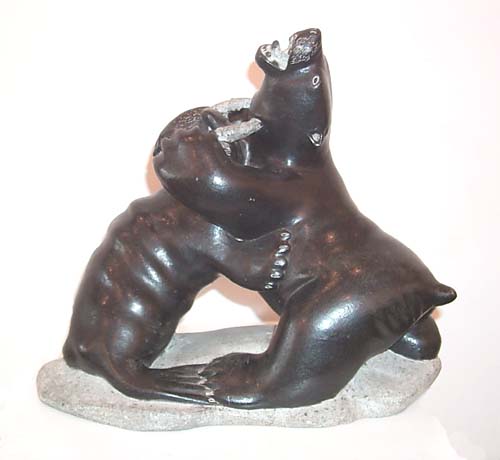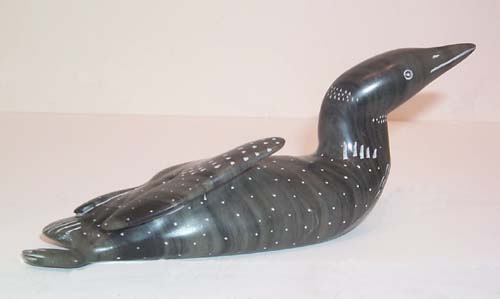|
|
Canku Ota |
|
|
(Many Paths) |
||
|
An Online Newsletter Celebrating Native America |
||
|
June 29, 2002 - Issue 64 |
||
|
|
||
|
Inuit Art |
||
|
Our thanks to Spirits
of the North Gallery for sharing this information with us.
|
||
|
|
|
Photo
No.
|
1.
|
2.
|
3.
|
4.
|
|
Title
|
Bear
|
Drummer
singing with a Shaman
|
Bear
and Walrus
|
Loon
|
|
Artist
|
Isaccie
Etidloie
|
Dwayne
Koe
|
Joanassie
Jack (Itukalla)
|
Jimmy
Iqaluk
|
|
Nation
|
Cape
Dorset
|
Aklavik
(N.W.Territories)
|
Pouungnituk
|
Sanikiluaq
|
|
Medium
|
Serpentine
|
Brazilian
soapstone/wood
|
Soapstone
|
Argillite
|
 On
1 April 1999, Nunavut became Canada's newest territory. Covering about
1.9 million square kilometres of land and water, and spanning three time
zones, Nunavut is home to about 25, 000 people. On
1 April 1999, Nunavut became Canada's newest territory. Covering about
1.9 million square kilometres of land and water, and spanning three time
zones, Nunavut is home to about 25, 000 people.
The name means "our land" in Inuktitut, the language of the Inuit, who make up 85% of the population of Nunavut. Nunavut's capital is Iqaluit, at the head of Frobisher Bay on Baffin Island. The name Iqaluit means "place of many fish" in Inuktitut. Inuit Sculpture Prehistoric Arctic Art The people of the Thule culture (ancestors of today's Inuit) migrated from northern Alaska around 1,000 A.D. and drove or wiped out the earlier Dorset inhabitants. Thule art was based on Alaskan prototypes; it included some human and animal figures, but consisted primarily of the graphic embellishment of utilitarian objects such as combs, needle cases, harpoon toggles and gaming pieces. The decorative or figurative incised markings on these objects do not seem to have had religious significance.
Inuit Sculpture in Recent Times The contemporary period of Inuit art began in the late 1940s. When the federal government recognized the potential economic benefit to the Inuit, it actively encouraged the development and promotion of Inuit sculpture, greatly assisted by the Hudson's Bay Company and the Canadian Handicrafts Guild. Inuit-owned cooperatives were established in the 1950s and 60s in most Arctic communities, as well as art marketing agencies in southern Canada. As well as providing much needed income in isolated Arctic villages, Inuit sculpture has achieved an international reputation as a major contemporary art form. Imagery and Styles The themes of Arctic wildlife, and traditional Inuit hunting and family scenes are still popular but spirit figures, and mythological and shamanic images also abound. Styles, too, range from naturalism or decorative stylization to minimal abstraction, and from brutal expressionism to whimsical surrealism. The personal styles of individual artists are readily identifiable by those who take time to look more closely. Regional Styles The sculpture of Arctic Quebec (Nouveau Québec; Nunavik) tends to be naturalistic, and is often narrative in nature. Animals and realistic hunting scenes, as well as legends and stories, are favoured subjects. The predominantly grey stones are generally blackened and polished, then incised. Artists from southern Baffin Island work in a variety of stone types. These sculptors seem to view the stone as a challenge, working against it and fashioning intricate, delicate and dramatic pieces with flair. Elegant or humorous animals are popular subjects. The sculpture of the Central Arctic varies from a kind of expressive realism to surrealism, with a focus on spiritual or shamanic themes. Facial features are often exaggerated, with intricate, inlaid details. Stone and whalebone are popular. The Keewatin stones are grey to black in colour and hard. Artists use this "stoneness" as an expressive element in their work. Details are few, and many works are not highly polished. Human subjects, especially family scenes, predominate. Methods and Materials Although the generic term "soapstone" is commonly used, this is a bit misleading. Soapstone, a soft talc steatite, is not used nearly as much as the harder serpentine, serpentinite, siltstone, argillite, dolomite, quartz and other types. Stone is the most versatile carving material because it can be worked to almost any size and shape. Its colours range from rather dull grey to luscious, almost semi-precious greens, whites, blue-greens, blacks, etc. Ivory, whalebone, antler and horn are more restrictive, but Inuit sculptors have nevertheless managed to take advantage of their naturally occurring shapes to produce a seemingly endless variety of forms and subjects.
Materials are often in short supply, and artists must travel great distances overland or by boat to quarry quantities of good quality stone. Once the materials are obtained, carving proceeds in a fairly straightforward manner. The necessary skills, perfected in the fashioning of traditional implements, have been passed down through generations of Inuit. Most sculptures are still produced with hand tools, although a growing number of artists use small power tools as well. Saws, axes and adzes, hammers and chisels are used for the initial roughing out stages of a carving. Files, rasps and, finally, steel wool and sandpaper are utilized for fine work and finishing. Penknives or nails may be used for detailed incising. Carving is generally messy and stone dust can be hazardous if inhaled. For these reasons, Inuit sculptors prefer to work outdoors, even in wintertime. Unlike many southern artists, Inuit carvers have a direct relationship with their materials. Most sculptors still use small hand tools such as hatchets, files, rasps and knives. The sculpture from other areas of Canada's Arctic is perhaps not quite so well known. Naturalistic animal and hunting themes predominate in the art from northern Baffin Island, the Western Arctic and Labrador. |
|
|
||
|
|
||
| Canku Ota is a free Newsletter celebrating Native America, its traditions and accomplishments . We do not provide subscriber or visitor names to anyone. Some articles presented in Canku Ota may contain copyright material. We have received appropriate permissions for republishing any articles. Material appearing here is distributed without profit or monetary gain to those who have expressed an interest. This is in accordance with Title 17 U.S.C. section 107. | ||
|
Canku Ota is a copyright © 2000, 2001, 2002 of Vicki Lockard and Paul Barry. |
||
 |
 |
|
|
The "Canku Ota - A Newsletter Celebrating Native America" web site and its design is the |
||
|
Copyright © 1999, 2000, 2001, 2002 of Paul C. Barry. |
||
|
All Rights Reserved. |
||
 A
colder climate disrupted the Thule culture in the 16th century, about
the same time as contact with the white man began. Inuit began to barter
with whalers, missionaries and other foreigners. Carvings of animals,
as well as replicas of tools and western-style objects, most often fashioned
from ivory, became common trade goods. The first few centuries of European
contact are usually referred to as the Historic Period.
A
colder climate disrupted the Thule culture in the 16th century, about
the same time as contact with the white man began. Inuit began to barter
with whalers, missionaries and other foreigners. Carvings of animals,
as well as replicas of tools and western-style objects, most often fashioned
from ivory, became common trade goods. The first few centuries of European
contact are usually referred to as the Historic Period. With
the exception of Baker Lake, the major Inuit sculpture producing settlements,
mostly ranging in population from a few hundred to 1,000 people, dot
the Arctic coastline. While each community has its own style, certain
regional characteristics are apparent.
With
the exception of Baker Lake, the major Inuit sculpture producing settlements,
mostly ranging in population from a few hundred to 1,000 people, dot
the Arctic coastline. While each community has its own style, certain
regional characteristics are apparent.  Stone
has replaced ivory as the most popular carving material in contemporary
Inuit art. This has led not only to a greater variety of colours and
forms, but also to the larger size of many modern Inuit sculptures.
Ancient weathered whalebone is another popular carving material, but
international restrictions on its use and that of ivory have resulted
in a decline in their use. Caribou antler and musk-ox horn are also
carved when available. Many works combine two or more of these materials;
for example, antler or ivory is often used as inlay in stone sculptures.
Stone
has replaced ivory as the most popular carving material in contemporary
Inuit art. This has led not only to a greater variety of colours and
forms, but also to the larger size of many modern Inuit sculptures.
Ancient weathered whalebone is another popular carving material, but
international restrictions on its use and that of ivory have resulted
in a decline in their use. Caribou antler and musk-ox horn are also
carved when available. Many works combine two or more of these materials;
for example, antler or ivory is often used as inlay in stone sculptures.